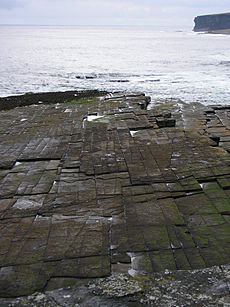Joint (geology) facts for kids

In geology, a joint is a type of crack that divides a rock into two parts. These parts move slightly away from each other, but they don't slide past each other. Joints form when a rock is pulled apart, reaching its breaking point. This is different from a fault, where the rock sections slide against each other.
Joints can point in many directions, but they are often found going straight up and down. Their surfaces can be smooth and clean, or they might look rough from rubbing against other joints. Joints usually appear in groups called "sets," where all the cracks in a set run parallel to each other.
How Joints Form and Change
Joints become much easier to see as rocks get weathered by the elements like rain and wind. When water gets into these cracks, it can slowly wear away the rock. Over a very long time, this process can even lead to the formation of large caves and hidden underground rivers.
Images for kids
-
Horizontal joints in the sedimentary rocks of the foreground and a more varied set of joints in the granitic rocks in the background. Image from the Kazakh Uplands in Balkhash District, Kazakhstan.
-
Joints in the Almo Pluton, City of Rocks National Reserve, Idaho.
-
Columnar jointed basalt in Turkey
-
Columnar jointing in basalt, Marte Vallis, Mars
-
Recent tectonic joint intersects older exfoliation joints in granite gneiss, Lizard Rock, Parra Wirra, South Australia.
-
Joint spacing in mechanically stronger limestone beds shows increase with bed thickness, Lilstock Bay, Somerset
See also
 In Spanish: Diaclasa para niños
In Spanish: Diaclasa para niños










